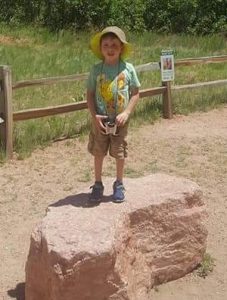
Will was born via emergency cesarean. As soon as they pulled him out, the doctors immediately noticed his feet were different. They diagnosed him immediately with bilateral vertical talus. He also has sacral agenesis/caudal regression syndrome.

For treatment of the vertical talus, He began serial casting at 3 weeks old. Serial casting is process of applying and removing a series of lightweight casts. Every few weeks, he got new casts with the angle of the cast changed slightly to stretch his muscles and move the joints in his feet a little closer to the correct foot position.
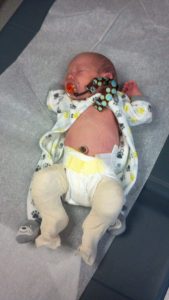
He had his first surgery at 3 months old. They preformed a bilateral achilles tenotomy, talonovicular release, and pinning. This surgery involves cutting the Achilles tendon and pining the foot in position, then casting.
After 6 more weeks in casts, the casts were removed and his pins fell out on their own. He was put in a Ponseti bar for 23 hours a day/7 days a week. A Ponseti bar is a device where small, lace up boots are attached to a rigid bar. The bar is connected to both boots, so it keeps the child’s feet in a specific position. For vertical talus, the feet are set at 0 degrees, straight forward.

We found out soon afterwards that the surgery was not successful, so his orthopedic surgeon scheduled a much more invasive surgery, for his feet. He had that at 15 months old. That surgeon made it seem like that was our only option for correction.
Once those casts were removed, we were told his talus bones were still oblique, not fully corrected. The talus bone is the small bone in the ankle that sits between the tibia and fibula (bones of the lower leg) and the heel bone. The talus connects the lower leg to the foot. In children, with oblique talus, the talus bone is positioned in the wrong direction while weight bearing, but lines up correctly when the foot is pointed downwards.
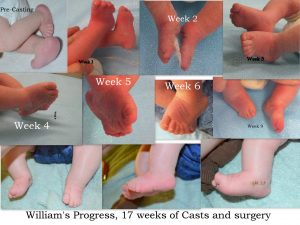
His doctor told us that this was the best that could be done. He was then in AFOs, or ankle foot orthotics”, 23 hours a day/7 days a week. AFO’s are molded plastic braces that fit around the foot and calf. They attach with velcro straps and can fit inside shoes. They keep the feet in the correct position.
We then sought out Dr. Matthew Dobbs in St. Louis, creator of the Dobbs bar device. It was a 6 hour drive from our home, but worth every mile. Will was 22 months old. Dr. Dobbs did serial castings over 2.5 weeks and then did another bilateral achilles tenotomy, talonovicular reduction, and pinning. Will was in casts for 2 weeks, had a cast change, and then was in casts for another 6 weeks. He then had a quick surgery to remove the pins.
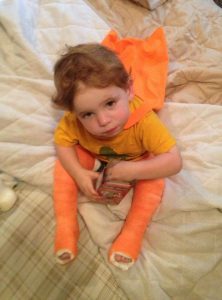
For the first time, his feet were fully corrected. He was in AFOs during the daytime and the Dobbs bar at night. The Dobbs bar is similar to the Ponseti bar, but it allows the legs to move independently even though the feet are fixed in a specific position. However, soon after the casts were removed, he developed cellulitis and MRSA, two kinds of infections. He was hospitalized over his second birthday and had to have a PICC line for 6 weeks and IV antibiotics for 6 weeks. A PICC line is tube that is inserted into a vein in your child’s arm, leg or neck. The tip of this catheter goes into a large vein that carries blood into the heart and it can be used to deliver medicine for infections.
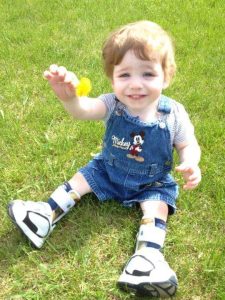
Sometimes the contracted muscles in the legs and feet return to the position before surgery and another surgery is needed to re-correct the feet. This happened to Will’s feet, and Dr. Dobbs repeated the previous surgery, with serial casting over 2 weeks again. He was 3 years old.
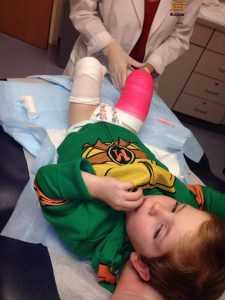
When he was 4 years old, he had tendon releases on both his big toes and his left foot pinky toe. They were curling under and causing him pain when he walked. He was in half leg casts for just 2 weeks this time.
Just a few weeks before he turned 5 he had to have surgery on his left foot for his big toe and pinky toe again. This surgery helped fix his gait.
Because he had so many surgeries in so few years, his skin began to die while his cast was on. It took his skin months to heal.
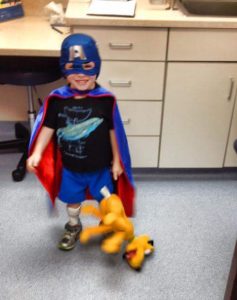
Our journey through treatment of bilateral vertical talus was a long one, with many unexpected twists and turns, but as of now, Will can walk, run, and climb like most little kids his age.

